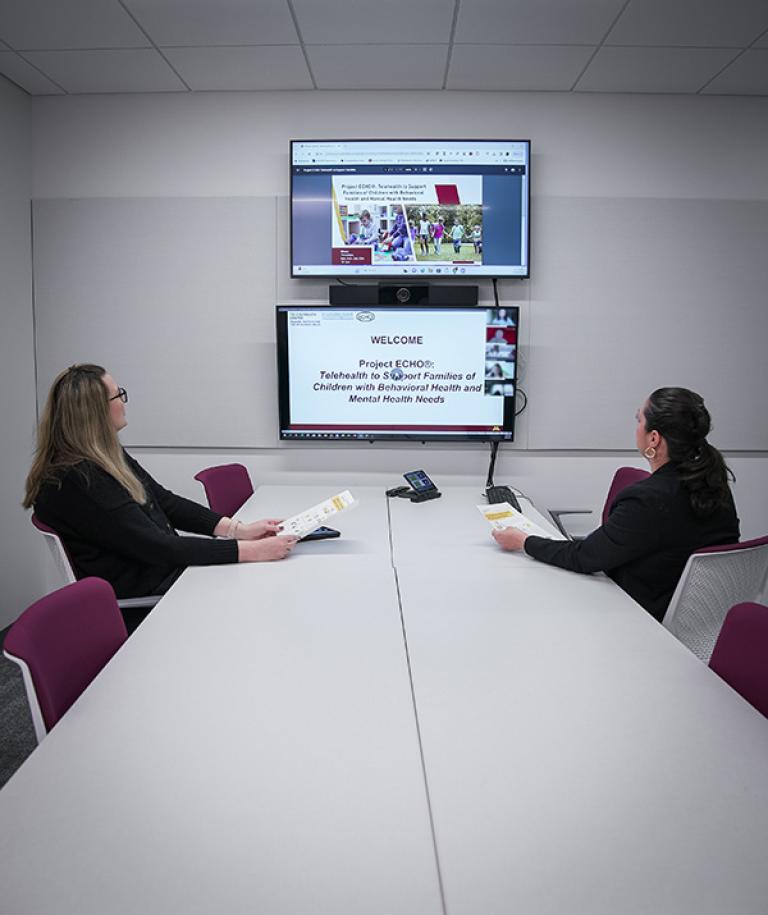2024 Spring / Summer

Providing care from afar
The MIDB’s TELEHEALTH INITIATIVE LEADS THE WAY IN BEHAVIORAL HEALTH ACCESS
One of the lasting effects of the COVID-19 pandemic was the adoption of telecommunications in numerous areas of society. Communication via screen has been available for some time, of course, but the pandemic brought on its use with greater urgency and ubiquitousness. A prime example is in the realm of healthcare. Providers unable to see their patients in person due to proximity or quarantine had a new outlet for their services.
“The pandemic resulted in a very clear and swift demonstration of human ingenuity regarding the workforce and interactions with patients, research participations, and trainees,” says Damien Fair, PhD, a professor in the Institute of Child Development (ICD) and the Redleaf Endowed Director of the Masonic Institute for the Developing Brain (MIDB), a collaboration between CEHD and the Medical School. “New forms of telecommunications, online assessments, and online training emerged from seemingly nowhere.”
MIDB is at the forefront of these advances with its TeleOutreach Research Core and TeleOutreach Center led by the Institute on Community Integration (ICI) and directed by Jessica Simacek, PhD. “We are innovating in a place that can provide access to services and care in ways that were unheard of even just a few years ago,” Fair says. “For MIDB, ICI, and the work by Jessica, this became an opportunity to re-think how we engage traditionally underrepresented populations and reduce inequalities in health and training, particularly in rural communities, military families, and communities with limited access to our institutions.”
Simacek, a Department of Educational Psychology alum, has been involved in telehealth research for nearly 10 years. Much of her work is focused on supporting children with neurological disabilities such as autism.
“We found that kids have to wait a long time to access the supports they and their families need,” she says. “This has been a problem for a long time.” It is even worse in geographically dispersed areas—there might not be specialists in regions near where families live, necessitating their need to travel far for services.

The TeleOutreach Center was established in 2020. The center implemented telehealth to support families who had no easy means to travel long distances—it was a tool designed to connect with families while they waited for support. Additionally, the center provides training and technical assistance to professionals in the field. Since its inception, the center has provided support to 241 children with developmental, emotional, or behavioral health needs and hosted 94 training sessions for 4,532 attendees.
With the 2020 pandemic, telehealth became near universal. “Providers had to do everything remotely,” Simacek says. “That certainly wasn’t ideal, but it did force everyone to try to use telehealth in some way or another. That urgency has gone away, which is very good, but other urgencies remain that must be addressed, such as extraordinarily long periods of time that most families spend on waitlists prior to accessing developmental and behavioral specialists for their children. We are now trying to disentangle and figure out where telehealth can be helpful to promote access to care faster and to improve care quality.”
In particular, this means using telehealth to support populations that have the greatest challenges accessing care: those in rural or geographically dispersed locations. In many cases, these are military families. To assist these families, the Department of Defense recently awarded the MIDB $3.5 million to partner on a study: “A Research Collaboratory to Explore Best Practices for Expanding Access to Care Through Expansion and Support of Telehealth Care for Children and Families with Behavioral Health Needs.” Simacek is the PI of the study. The project will entail creating a “Minnesota Telehealth Innovation” site to provide training and assistance to providers, educators, and families to improve service access.
“There are many ways in which this study will change the way we do care for underserved populations for years to come,” says Fair, a co-PI of the project. “I think it is not shocking to anyone to hear that our health care system in Minnesota is complicated. I’m a fairly educated, well-intentioned patient myself who has difficulty navigating this system, and if it wasn’t for the persistence of my wife, I would be fearful my children wouldn’t get the care they need. Having systems in place to speak with providers and supporters on how to get the care one’s family needs, no matter where they are in the state or really across many states, is of enormous value to the healthy development of our kids long term.”

Thinking long term is top of mind when Simacek reflects on telehealth. She envisions the many ways it can grow: engaging with more areas of the state, developing new technologies, and providing more training. “I could see us expanding more deeply into some other focus areas where we can take these methods that have been working well and adapt them to support children and youth with other developmental and behavioral health needs who are facing other related barriers to care access,” she says.
Fair is excited that the telehealth initiative is built upon the strengths of many at the University. “It is literally the embodiment of what was imagined when we started this experiment we now call the MIDB,” he says. “We have brought together folks in pediatrics, psychiatry, ICI, ICD, psychology, and more. Support structures around web development, software development, data security, databasing, mobile technologies, and more from Research Computing, Health Sciences Technology, CEHD, and the Medical School are also contributing to this amazing endeavor.”
—KEVIN MOE
Learn more: z.umn.edu/MIDB-Telehealth
Photo credit(s): Adam Guggenheim, Pete McCauley, and pexels.com